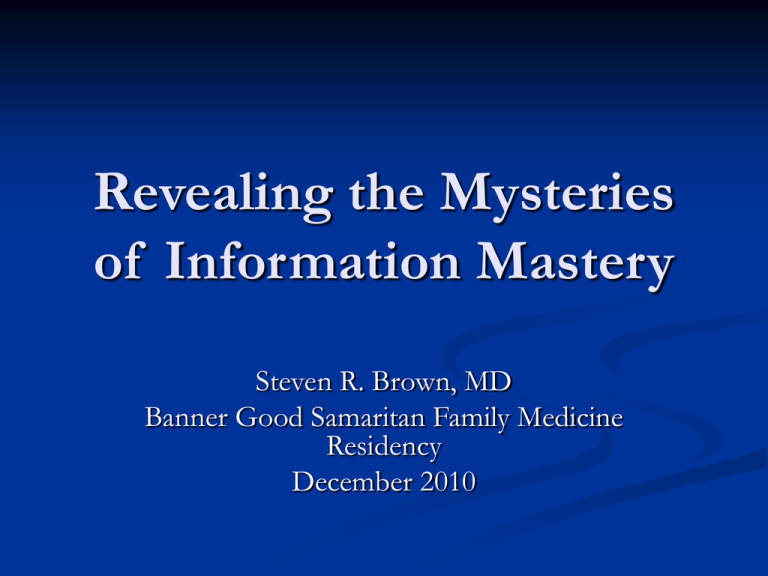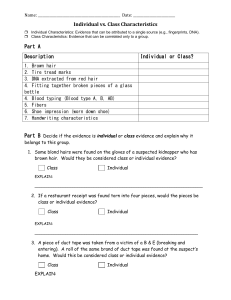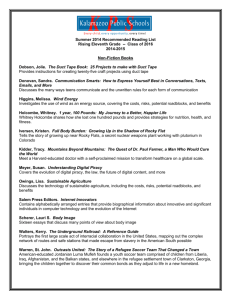UofAfacdevinfomastery
advertisement

Revealing the Mysteries of Information Mastery Steven R. Brown, MD Banner Good Samaritan Family Medicine Residency December 2010 “It’s not how much you know, it’s how fast you can find the answer.”® How helpful is the answer? The usefulness equation Usefulness = Relevance x Validity Work Shaughnessy and Slawson How will you find information? How will it find you? The information jungle MEDLINE: 9 Million articles adding 300,000/year In primary care to keep up to date, we would need to read 17 articles a day, 365 days a year But… Less than 15% of articles published on a topic are useful Clinical trials are of varying quality “Information anxiety” “The frustration that occurs when there is a great deal of information, but it doesn’t tell us what we want or need to know.” Richard Wurman. What’s the problem? We generate questions About 5 times for every inpatient case and twice for every 3 clinic patients. Thus for each day of 25 patients seen, we generate ~15 questions. We get answers for less than a third (33%) of them. Covell DG, UmanGC, Manning PR. Information needs in office practice: are they being met? Ann Intern Med 1985;103:596-9 How do we find answers? Clinical questions Background General knowledge about a condition or thing Foreground Specific knowledge to inform clinical decisions or actions “PICO” Questions change as experience increases P atient/Population I ntervention C omparison O utcome In post-menopausal women, what are the effects of HRT on bone density/fractures? patient post-menopausal woman intervention hormone replacement therapy outcome(s) osteoporosis bone mineral density fracture The “O” in PICO Applicability to Practice DOE (disease oriented evidence) POEM (patient oriented evidence that matters) Until recently, only Aimed at evidence that information available patients care about & Aimed at increasing our clinicians care about their understanding of disease patients Crucial to medicine, how a HCTZ in HTN reduces “disease works” morbidity and mortality DOE vs. POEM “Assuming” “Knowing” POEM: Patient-Oriented Evidence that Matters What matters to patients and their doctors? Morbidity (fractures, heart attacks) Mortality Cost Example: HCTZ lowers risk of stroke, myocardial infarction What doesn’t matter to patients? Lab values (HDL, LDL) Clinical measures (blood pressure) Disease markers (bone density) Disease Oriented Evidence (DOE) Important for understanding the disease process, but not ready for “prime time” Comparing DOEs and POEMs Example Antiarrhythmic Therapy DiseaseOriented Evidence Patient-Oriented Evidence that Matters Drug X PVCs Drug X increases on ECG mortality Comment POEM study contradicts DOE study HCTZ HCTZ POEM agrees Antihypertensive Antihypertensive Antihypertensive therapy BP therapy mortality with DOE therapy DOE exists, but PSA screening ? whether PSA the important detects prostate screening POEM is Prostate cancer early mortality unknown Screening The usefulness equation revisited Usefulness = Relevance x Validity Work Shaughnessy and Slawson The worksheet Effect on Patient-Oriented Outcomes Symptoms Functioning Quality of Life Lifespan Valid PatientOriented Evidence Effect on Disease Markers A1c in diabetes MICs in infection BMD in osteoporosis Effect on Risk Factors for Disease Improvement in markers (blood pressure, cholesterol) Uncontrolled Observations & Conjecture Physiologic Research Preliminary Clinical Research Case reports Observational studies Validity of Evidence Highly Controlled Research Randomized Controlled Trials Systematic Reviews Strength of Recommendation Taxonomy Effect on Patient-Oriented Outcomes Symptoms Functioning Quality of Life Lifespan Effect on Disease Markers Diabetes Arthritis Peptic Ulcer SORT B SORT A SORT C Effect on Risk Factors for Disease Improvement in markers (blood pressure, cholesterol) Uncontrolled Observations & Conjecture Physiologic Research Preliminary Clinical Research Case reports Observational studies Validity of Evidence Highly Controlled Research Randomized Controlled Trials Systematic Reviews Assessing validity The 5 “A”s of Evidence-based Medicine Ask Acquire Appraise Apply Assess Secondary sources of literature Let someone else do the hard work! DOE vs. POEM some practice Finding the answer Ask a good question Use efficient methods and sources Question includes relevance screen Use abstract to briefly assess validity Have relevant, valid information find you! Evidence-based Resources American Family Physician Dynamed www.dynamicmedical.com Essential Evidence Plus www.essentialevidenceplus.com PubMed ACP Pier Primary Care Medical Abstracts http://ccme.org/pcma/ 2011 AzAFP Clinical Education Conference March 4-5, 2011, Phoenix, AZ. www.azafp.org. Course director, Mark Ebell, MD. Information mastery proficiency Level 0: Decisions based on 3 influences: Patient request, local experts, pharm. reps Level 1: Use the highest quality information to guide clinical decisions (100%) Level 2: Search, evaluate, and make available specialty specific Level 1 information (<1%) Level 3: Create original research (primary) or systematic reviews (secondary) So, does duct tape work for warts? One answer: Duct tape vs. cryotherapy in the treatment of the common wart Arch Ped Adol Med 2002;156 “A supply of standard duct tape was provided.” “Cut the tape as close to the size of the wart as possible.” “Leave the tape in place for 6 days.” “If the tape falls off…reapply a new piece of tape.” After 6 days, remove the tape, debride, and apply again the next morning. Cryotherapy causes “fear and discomfort for many children.” Duct tape vs. cryotherapy in the treatment of the common wart Arch Ped Adol Med 2002;156 85% resolution with duct tape vs. 60% resolution with cryotherapy at 2 months ARR = 25% NNT = 4








